Jintao Zhang
TurboDiffusion: Accelerating Video Diffusion Models by 100-200 Times
Dec 18, 2025Abstract:We introduce TurboDiffusion, a video generation acceleration framework that can speed up end-to-end diffusion generation by 100-200x while maintaining video quality. TurboDiffusion mainly relies on several components for acceleration: (1) Attention acceleration: TurboDiffusion uses low-bit SageAttention and trainable Sparse-Linear Attention (SLA) to speed up attention computation. (2) Step distillation: TurboDiffusion adopts rCM for efficient step distillation. (3) W8A8 quantization: TurboDiffusion quantizes model parameters and activations to 8 bits to accelerate linear layers and compress the model. In addition, TurboDiffusion incorporates several other engineering optimizations. We conduct experiments on the Wan2.2-I2V-14B-720P, Wan2.1-T2V-1.3B-480P, Wan2.1-T2V-14B-720P, and Wan2.1-T2V-14B-480P models. Experimental results show that TurboDiffusion achieves 100-200x speedup for video generation even on a single RTX 5090 GPU, while maintaining comparable video quality. The GitHub repository, which includes model checkpoints and easy-to-use code, is available at https://github.com/thu-ml/TurboDiffusion.
Towards Stable and Structured Time Series Generation with Perturbation-Aware Flow Matching
Nov 18, 2025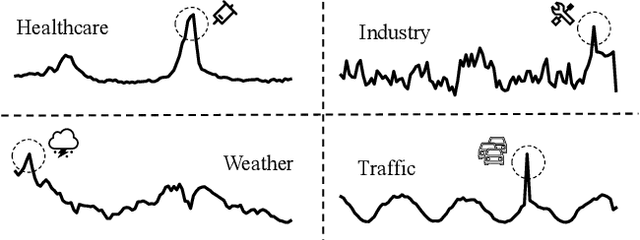


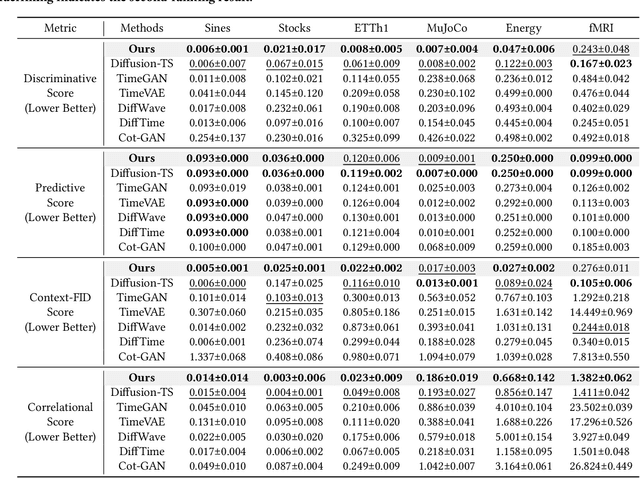
Abstract:Time series generation is critical for a wide range of applications, which greatly supports downstream analytical and decision-making tasks. However, the inherent temporal heterogeneous induced by localized perturbations present significant challenges for generating structurally consistent time series. While flow matching provides a promising paradigm by modeling temporal dynamics through trajectory-level supervision, it fails to adequately capture abrupt transitions in perturbed time series, as the use of globally shared parameters constrains the velocity field to a unified representation. To address these limitations, we introduce \textbf{PAFM}, a \textbf{P}erturbation-\textbf{A}ware \textbf{F}low \textbf{M}atching framework that models perturbed trajectories to ensure stable and structurally consistent time series generation. The framework incorporates perturbation-guided training to simulate localized disturbances and leverages a dual-path velocity field to capture trajectory deviations under perturbation, enabling refined modeling of perturbed behavior to enhance the structural coherence. In order to further improve sensitivity to trajectory perturbations while enhancing expressiveness, a mixture-of-experts decoder with flow routing dynamically allocates modeling capacity in response to different trajectory dynamics. Extensive experiments on both unconditional and conditional generation tasks demonstrate that PAFM consistently outperforms strong baselines. Code is available at https://anonymous.4open.science/r/PAFM-03B2.
On Continuous Optimization for Constraint Satisfaction Problems
Oct 06, 2025



Abstract:Constraint satisfaction problems (CSPs) are fundamental in mathematics, physics, and theoretical computer science. While conflict-driven clause learning Boolean Satisfiability (SAT) solvers have achieved remarkable success and become the mainstream approach for Boolean satisfiability, recent advances show that modern continuous local search (CLS) solvers can achieve highly competitive results on certain classes of SAT problems. Motivated by these advances, we extend the CLS framework from Boolean SAT to general CSP with finite-domain variables and expressive constraints. We present FourierCSP, a continuous optimization framework that generalizes the Walsh-Fourier transform to CSP, allowing for transforming versatile constraints to compact multilinear polynomials, thereby avoiding the need for auxiliary variables and memory-intensive encodings. Our approach leverages efficient evaluation and differentiation of the objective via circuit-output probability and employs a projected gradient optimization method with theoretical guarantees. Empirical results on benchmark suites demonstrate that FourierCSP is scalable and competitive, significantly broadening the class of problems that can be efficiently solved by CLS techniques.
Time Series Forecasting as Reasoning: A Slow-Thinking Approach with Reinforced LLMs
Jun 12, 2025

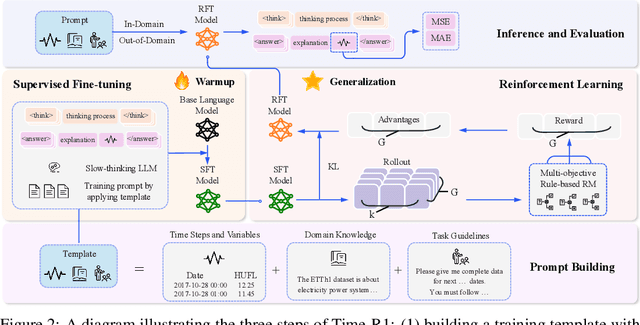
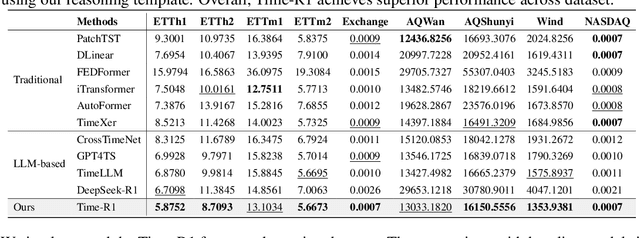
Abstract:To advance time series forecasting (TSF), various methods have been proposed to improve prediction accuracy, evolving from statistical techniques to data-driven deep learning architectures. Despite their effectiveness, most existing methods still adhere to a fast thinking paradigm-relying on extracting historical patterns and mapping them to future values as their core modeling philosophy, lacking an explicit thinking process that incorporates intermediate time series reasoning. Meanwhile, emerging slow-thinking LLMs (e.g., OpenAI-o1) have shown remarkable multi-step reasoning capabilities, offering an alternative way to overcome these issues. However, prompt engineering alone presents several limitations - including high computational cost, privacy risks, and limited capacity for in-depth domain-specific time series reasoning. To address these limitations, a more promising approach is to train LLMs to develop slow thinking capabilities and acquire strong time series reasoning skills. For this purpose, we propose Time-R1, a two-stage reinforcement fine-tuning framework designed to enhance multi-step reasoning ability of LLMs for time series forecasting. Specifically, the first stage conducts supervised fine-tuning for warmup adaptation, while the second stage employs reinforcement learning to improve the model's generalization ability. Particularly, we design a fine-grained multi-objective reward specifically for time series forecasting, and then introduce GRIP (group-based relative importance for policy optimization), which leverages non-uniform sampling to further encourage and optimize the model's exploration of effective reasoning paths. Experiments demonstrate that Time-R1 significantly improves forecast performance across diverse datasets.
Multimodal Forecasting of Sparse Intraoperative Hypotension Events Powered by Language Model
May 28, 2025Abstract:Intraoperative hypotension (IOH) frequently occurs under general anesthesia and is strongly linked to adverse outcomes such as myocardial injury and increased mortality. Despite its significance, IOH prediction is hindered by event sparsity and the challenge of integrating static and dynamic data across diverse patients. In this paper, we propose \textbf{IOHFuseLM}, a multimodal language model framework. To accurately identify and differentiate sparse hypotensive events, we leverage a two-stage training strategy. The first stage involves domain adaptive pretraining on IOH physiological time series augmented through diffusion methods, thereby enhancing the model sensitivity to patterns associated with hypotension. Subsequently, task fine-tuning is performed on the original clinical dataset to further enhance the ability to distinguish normotensive from hypotensive states. To enable multimodal fusion for each patient, we align structured clinical descriptions with the corresponding physiological time series at the token level. Such alignment enables the model to capture individualized temporal patterns alongside their corresponding clinical semantics. In addition, we convert static patient attributes into structured text to enrich personalized information. Experimental evaluations on two intraoperative datasets demonstrate that IOHFuseLM outperforms established baselines in accurately identifying IOH events, highlighting its applicability in clinical decision support scenarios. Our code is publicly available to promote reproducibility at https://github.com/zjt-gpu/IOHFuseLM.
SageAttention2++: A More Efficient Implementation of SageAttention2
May 28, 2025



Abstract:The efficiency of attention is critical because its time complexity grows quadratically with sequence length. SageAttention2 addresses this by utilizing quantization to accelerate matrix multiplications (Matmul) in attention. To further accelerate SageAttention2, we propose to utilize the faster instruction of FP8 Matmul accumulated in FP16. The instruction is 2x faster than the FP8 Matmul used in SageAttention2. Our experiments show that SageAttention2++ achieves a 3.9x speedup over FlashAttention while maintaining the same attention accuracy as SageAttention2. This means SageAttention2++ effectively accelerates various models, including those for language, image, and video generation, with negligible end-to-end metrics loss. The code will be available at https://github.com/thu-ml/SageAttention.
Sparse VideoGen2: Accelerate Video Generation with Sparse Attention via Semantic-Aware Permutation
May 24, 2025Abstract:Diffusion Transformers (DiTs) are essential for video generation but suffer from significant latency due to the quadratic complexity of attention. By computing only critical tokens, sparse attention reduces computational costs and offers a promising acceleration approach. However, we identify that existing methods fail to approach optimal generation quality under the same computation budget for two reasons: (1) Inaccurate critical token identification: current methods cluster tokens based on position rather than semantics, leading to imprecise aggregated representations. (2) Excessive computation waste: critical tokens are scattered among non-critical ones, leading to wasted computation on GPUs, which are optimized for processing contiguous tokens. In this paper, we propose SVG2, a training-free framework that maximizes identification accuracy and minimizes computation waste, achieving a Pareto frontier trade-off between generation quality and efficiency. The core of SVG2 is semantic-aware permutation, which clusters and reorders tokens based on semantic similarity using k-means. This approach ensures both a precise cluster representation, improving identification accuracy, and a densified layout of critical tokens, enabling efficient computation without padding. Additionally, SVG2 integrates top-p dynamic budget control and customized kernel implementations, achieving up to 2.30x and 1.89x speedup while maintaining a PSNR of up to 30 and 26 on HunyuanVideo and Wan 2.1, respectively.
SageAttention3: Microscaling FP4 Attention for Inference and An Exploration of 8-Bit Training
May 16, 2025Abstract:The efficiency of attention is important due to its quadratic time complexity. We enhance the efficiency of attention through two key contributions: First, we leverage the new FP4 Tensor Cores in Blackwell GPUs to accelerate attention computation. Our implementation achieves 1038 TOPS on RTX5090, which is a 5x speedup over the fastest FlashAttention on RTX5090. Experiments show that our FP4 attention can accelerate inference of various models in a plug-and-play way. Second, we pioneer low-bit attention to training tasks. Existing low-bit attention works like FlashAttention3 and SageAttention focus only on inference. However, the efficiency of training large models is also important. To explore whether low-bit attention can be effectively applied to training tasks, we design an accurate and efficient 8-bit attention for both forward and backward propagation. Experiments indicate that 8-bit attention achieves lossless performance in fine-tuning tasks but exhibits slower convergence in pretraining tasks. The code will be available at https://github.com/thu-ml/SageAttention.
CoMatcher: Multi-View Collaborative Feature Matching
Apr 02, 2025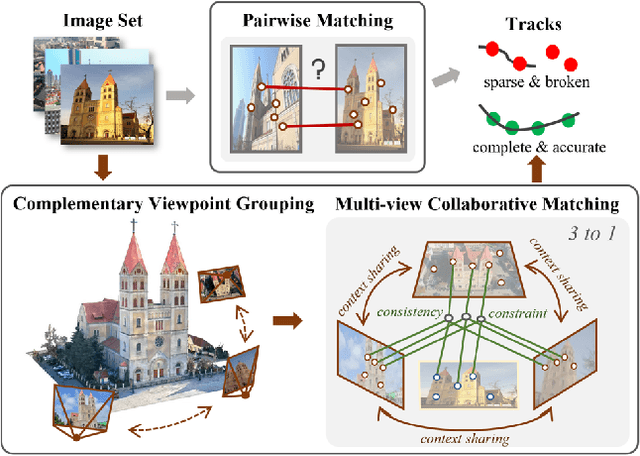
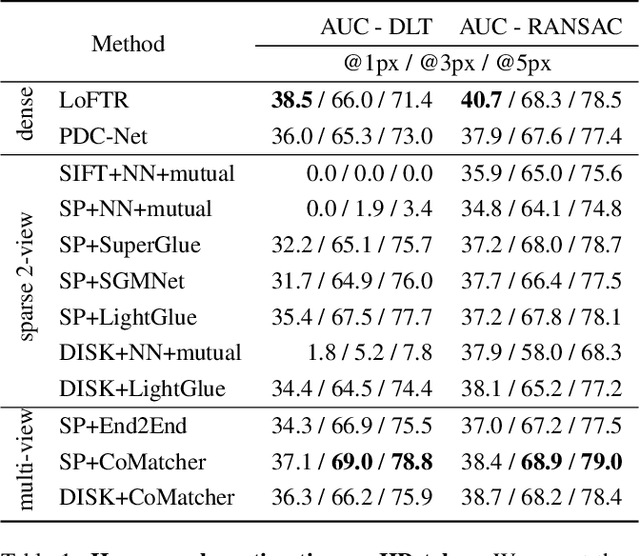
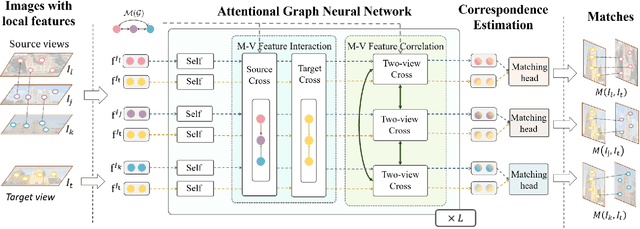
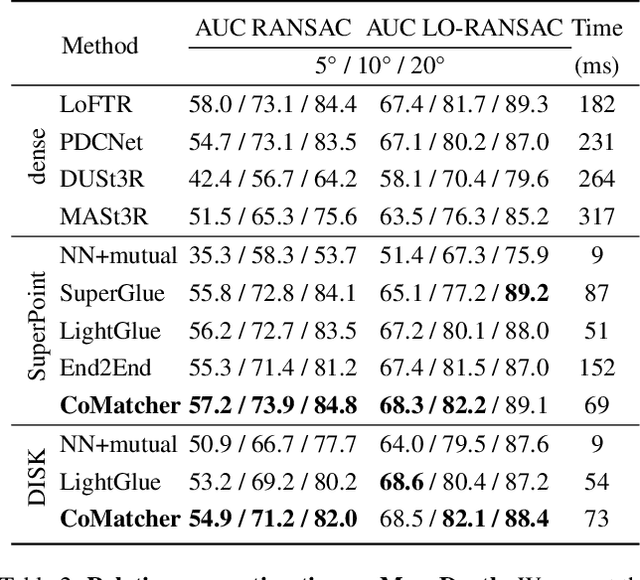
Abstract:This paper proposes a multi-view collaborative matching strategy for reliable track construction in complex scenarios. We observe that the pairwise matching paradigms applied to image set matching often result in ambiguous estimation when the selected independent pairs exhibit significant occlusions or extreme viewpoint changes. This challenge primarily stems from the inherent uncertainty in interpreting intricate 3D structures based on limited two-view observations, as the 3D-to-2D projection leads to significant information loss. To address this, we introduce CoMatcher, a deep multi-view matcher to (i) leverage complementary context cues from different views to form a holistic 3D scene understanding and (ii) utilize cross-view projection consistency to infer a reliable global solution. Building on CoMatcher, we develop a groupwise framework that fully exploits cross-view relationships for large-scale matching tasks. Extensive experiments on various complex scenarios demonstrate the superiority of our method over the mainstream two-view matching paradigm.
* 15 pages, 7 figures, to be published in CVPR 2025
Accurate INT8 Training Through Dynamic Block-Level Fallback
Mar 11, 2025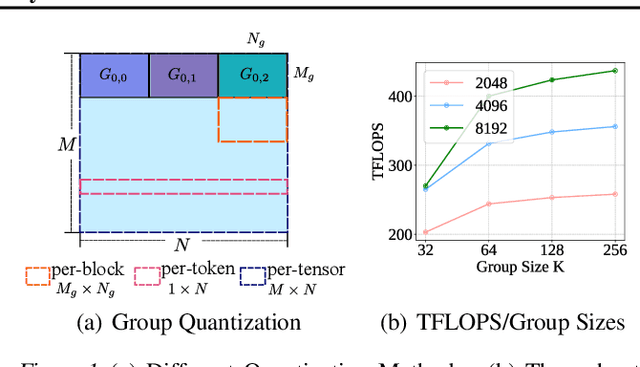
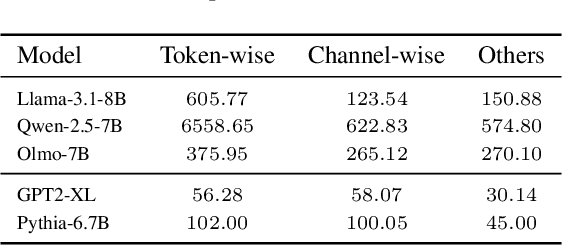
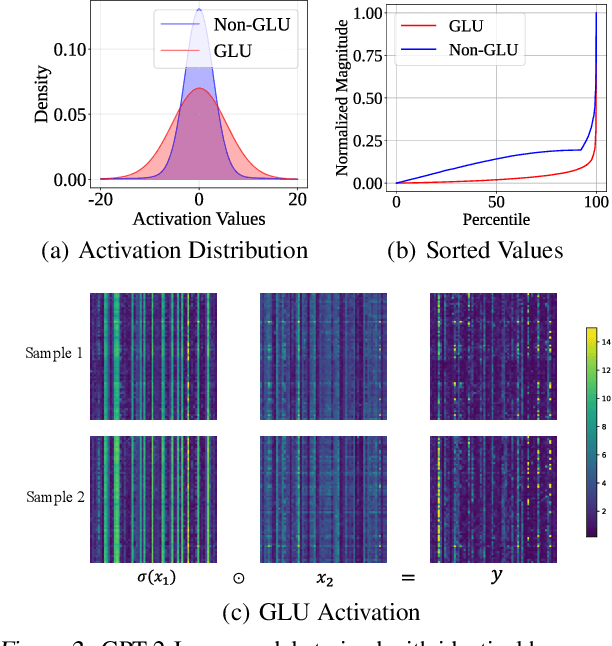
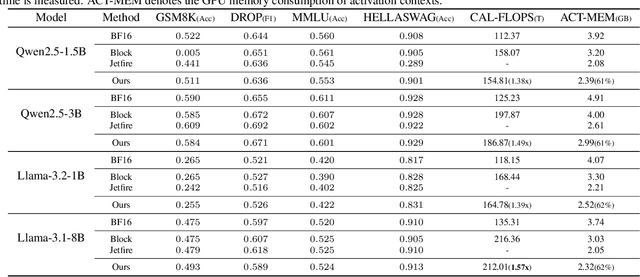
Abstract:Transformer models have achieved remarkable success across various AI applications but face significant training costs. Low-bit training, such as INT8 training, can leverage computational units with higher throughput, and has already demonstrated its effectiveness on GPT2 models with block-level quantization. However, it struggles with modern Transformer variants incorporating GLU units. This is because those variants demonstrate complex distributions of activation outliers. To address the challenge, we propose Fallback Quantization, implementing mixed-precision GEMM that dynamically falls back 8-bit to 16-bit for activation blocks containing outliers. Experiments show that our approach is robustly competent in both fine-tuning and pretraining settings. Moreover, our method achieves a 1.57x end-to-end training speedup on RTX4090 GPUs.
 Add to Chrome
Add to Chrome Add to Firefox
Add to Firefox Add to Edge
Add to Edge